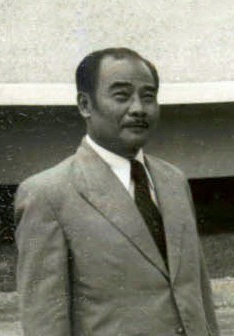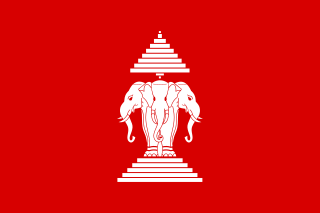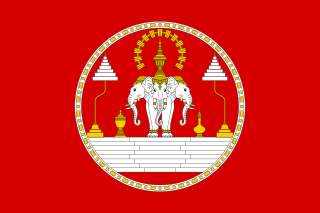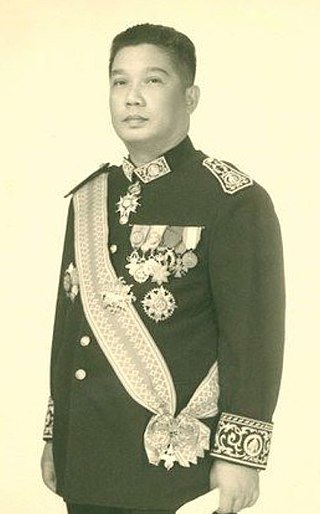
Prince Souphanouvong, nicknamed the Red Prince, was along with his half-brother Prince Souvanna Phouma and Prince Boun Oum of Champasak, one of the "Three Princes" who represented respectively the communist (pro-Vietnam), neutralist and royalist political factions in Laos. He was the President of Laos from December 1975 to October 1986.

The Kingdom of Laos was a landlocked country in Southeast Asia at the heart of the Indochinese Peninsula. It was bordered by Burma and China to the northwest, North Vietnam to the east, Cambodia to the southeast, and Thailand to the west and southwest. The country was governed as a constitutional monarchy that ruled Laos beginning with its independence on 9 November 1953. It survived until December 1975, when its last king, Sisavang Vatthana, surrendered the throne to the Pathet Lao during the civil war in Laos, who abolished the monarchy in favour of a Marxist–Leninist state called the Lao People's Democratic Republic, which has controlled Laos ever since.

Prince Souvanna Phouma was the leader of the neutralist faction and Prime Minister of the Kingdom of Laos several times.

Sisavang Vatthana or sometimes Savang Vatthana was the last king of the Kingdom of Laos and the 6th Prime Minister of Laos serving from 29 October to 21 November 1951. He ruled from 1959 after his father's death until his forced abdication in 1975. His rule ended with the takeover by the Pathet Lao in 1975, after which he and his family were sent to a re-education camp by the new government.

Prince Sauryavong Savang was the youngest son of King Savang Vatthana of Laos. In 1965, he married Princess Dalavan and they had four children, Sthira Sauryavong, Dayavant Sauryavong, Balavant Sauryavong, and Krishnajina Sauryavong.

The Three Princes was a name given to Princes Boun Oum, Souvanna Phouma and Souphanouvong who represented respectively the royalist, neutralist and communist factions in the Kingdom of Laos in the post-WWII period, especially during Laotian Civil War. The trio were named by King Sisavang Vatthana to form a coalition government following the independence of Laos.
Soulivong Savang, grandson of the last King of Laos Savang Vatthana, is the pretender to the Lao throne. Laos was a monarchy until 1975, when the communist Pathet Lao seized control of the nation, causing Savang Vatthana to abdicate his throne. Soulivong Savang lives in exile in Paris.

The Laotian Civil War (1959–1975) was a civil war in Laos waged between the Communist Pathet Lao and the Royal Lao Government from 23 May 1959 to 2 December 1975. It is associated with the Cambodian Civil War and the Vietnam War, with both sides receiving heavy external support in a proxy war between the global Cold War superpowers. It is known as the Secret War among the American CIA Special Activities Center, and Hmong and Mien veterans of the conflict.

The French protectorate of Laos was a French protectorate in Southeast Asia of what is today Laos between 1893 and 1953—with a brief interregnum as a Japanese puppet state in 1945—which constituted part of French Indochina. It was established over the Siamese vassal, the Kingdom of Luang Phrabang, following the Franco-Siamese crisis of 1893. It was integrated into French Indochina and in the following years further Siamese vassals, the Principality of Phuan and Kingdom of Champasak, were annexed into it in 1899 and 1904, respectively.

The Royal Lao Government was the ruling authority in the Kingdom of Laos from 1947 until the communist seizure of power in December 1975 and the proclamation of the Lao People's Democratic Republic. The Franco-Lao Treaty of 1953 gave Laos full independence but the following years were marked by a rivalry between the neutralists under Prince Souvanna Phouma, the right wing under Prince Boun Oum of Champassak, and the left-wing, Lao Patriotic Front under Prince Souphanouvong and future Prime Minister Kaysone Phomvihane. During this period, a number of unsuccessful attempts were made to establish coalition governments.

The Royal Lao Government in Exile (RLGE) is a Laotian government in exile opposed to the Lao People's Democratic Republic established on May 6, 2003, and seeks to reinstall a constitutional monarchy in Laos. The RLGE also seeks to end what it sees as the Vietnamization of Laos and the Lao-Viet special Brotherhood Treaty. It was most recently headed by then Prime-minister Khamphoui Sisavatdy and King Soulivong Savang.

Phoui Sananikone locally known as Phagna Houakhong was a politician and served as Prime Minister of the Kingdom of Laos from 1950 to 1951 and 1958 to 1959. Since entering government service he had held virtually every top position in the Lao cabinet. The majority of his work as politician concerned the independence and sovereignty of Laos in Southeast Asia, especially in regards of the western-oriented neutrality policy during the height of the Indochina Wars.

The Order of Civic Merit of the Kingdom of Laos was established on November 20, 1950 under Royal Ordinance No. 186 by H.M. Sisavang Phoulivong, The King of Laos. It is an Order of Civic Merit for civil officials and military officers. It was awarded for meritorious and courageous service to the State in three classes. Until 1975 the approval authority was the Prime Minister of the Royal Lao Government. The current approval authority is H.E. Professor Maha Khamphoui Sisavatdy, Prime Minister of the Royal Lao Government in Exile as an elected successor to the Office of the Prime Minister of the Royal Lao Government.
The 1960 Laotian coups brought about a pivotal change of government in the Kingdom of Laos. General Phoumi Nosavan established himself as the strongman running Laos in a bloodless coup on 25 December 1959. He would be himself overthrown on 10 August 1960 by the young paratrooper captain who had backed him in the 1959 coup. When Captain Kong Le impressed the American officials underwriting Laos as a potential communist, they backed Phoumi's return to power in November and December 1960. In turn, the Soviets backed Kong Le as their proxy in this Cold War standoff. After the Battle of Vientiane ended in his defeat, Kong Le withdrew northward to the strategic Plain of Jars on 16 December 1960.
The following lists events that happened during 1962 in Laos.
The following lists events that happened during 1963 in Laos.
The 1964 Laotian coups were two attempted coup d'etats against the Royal Lao Government. The 18 April 1964 coup was notable for being committed by the policemen of the Directorate of National Coordination. Although successful, it was overturned five days later by U.S. Ambassador Leonard Unger. In its wake, Neutralist Prime Minister Souvanna Phouma forged a fragile coalition with the Pathet Lao communists. On 4 August 1964, Defense Minister Phoumi Nosavan attempted to take over Vientiane with a training battalion. This coup was quickly crushed by the local Royal Lao Army troops, as the police sat out the conflict.










